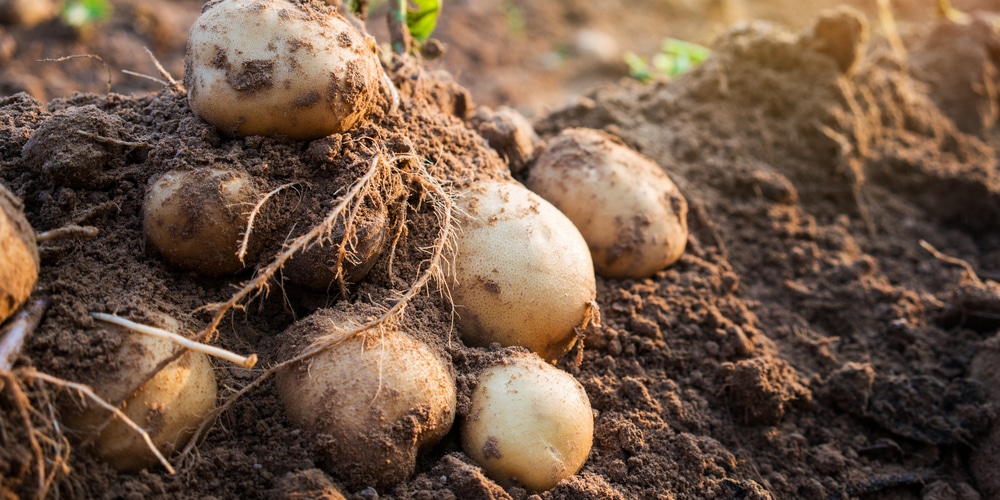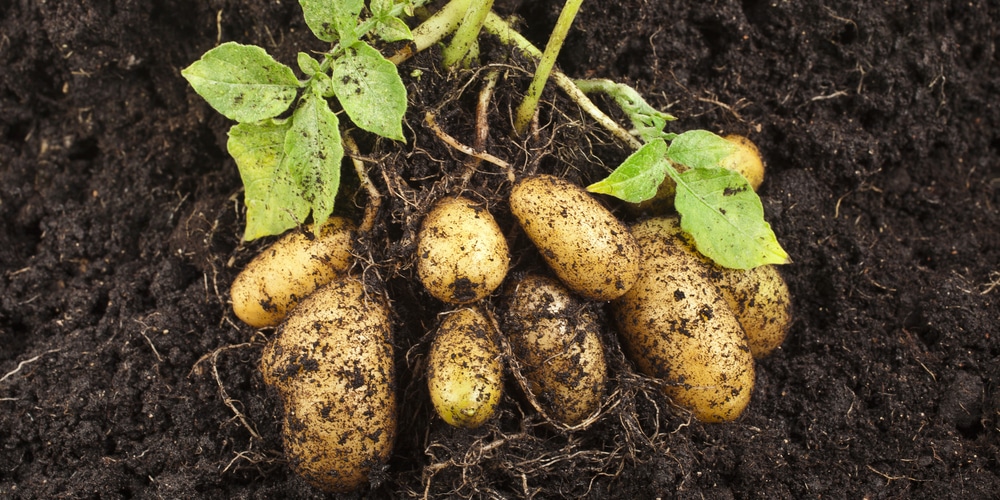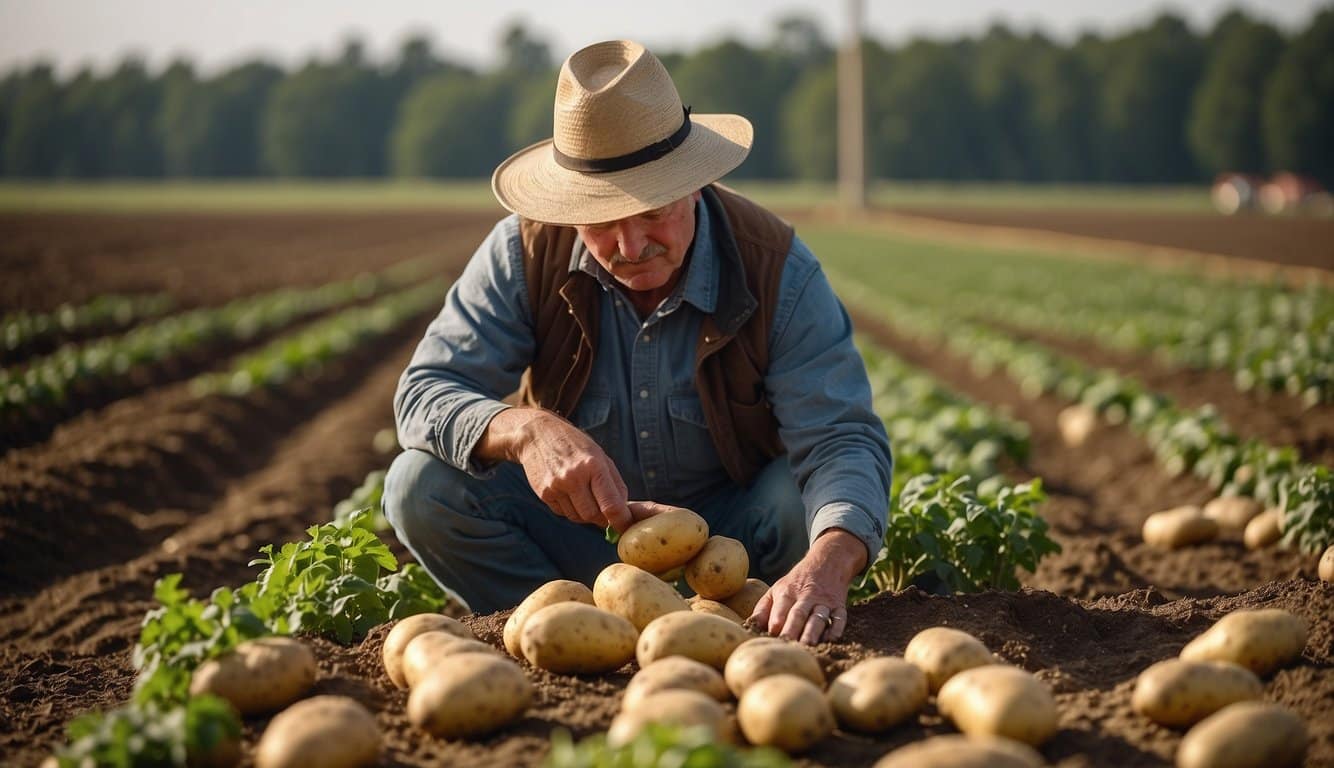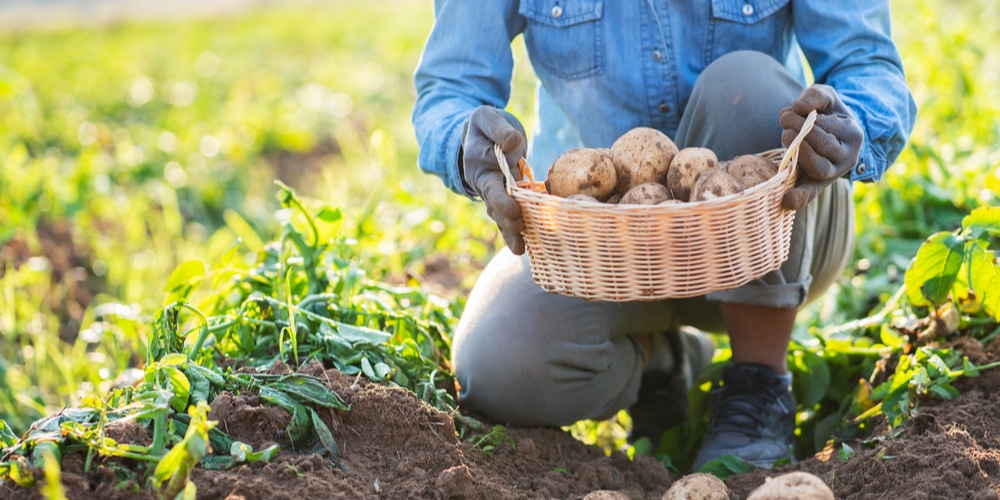| Question | When to Plant Potatoes in NC? |
|---|---|
| Answer | Late February to early April |
| More Info |
|
A More Detailed Answer
In North Carolina, gardeners should be attentive to timing when planting potatoes to ensure a successful harvest. The prime planting period falls between late February and early April.
Soil Temperature: Potatoes thrive in soil temperatures ranging from 45 to 60 degrees Fahrenheit.
Planting too early in cold soil may hamper growth, while planting too late in warm soil can affect tuber development.
Frost Dates: Potatoes are frost-sensitive. It’s crucial to schedule planting after the last average frost date has passed.
Gardeners should subtract 40 days from their region’s final expected frost date to determine the optimal indoor seed start date.
Planting Guidelines:
- Early Season: Late winter or early spring, once the soil is workable.
- Late Season: Late spring or early summer, particularly for heat-tolerant varieties.
Row and Seed Spacing:
- Depth: Plant seed pieces 6 inches deep.
- In-Row Spacing: Space seed pieces 10 inches apart.
- Between Rows: Allow for 3 feet to enable growth and hilling.
Example Planting Timeline:
| Date Range | Event |
|---|---|
| Late February – April | Plant early season potato varieties |
| April – May | Plant late season potato varieties |
Gardeners should note that an area’s specific altitude and microclimate can affect planting times.
Upon harvesting, potatoes should be stored in a cool, dry, and dark place for longevity.
Success is In The Soil
Proper soil preparation is crucial for a successful potato crop in North Carolina.
Gardeners should aim for well-drained, loamy soil with a pH between 5.0 and 5.5 to ensure optimal potato growth and health.
Testing Soil: Before planting, it’s recommended to test the soil. This will help determine the soil’s pH and nutrient levels, enabling gardeners to make necessary amendments.
Lime can be added to increase pH, while sulfur can help lower it if required.
Organic Matter: Enhancing the soil with organic matter is highly beneficial.
Compost or well-rotted manure will improve the soil structure, drainage, and nutrient content.
It’s ideal to incorporate about 2 to 4 inches of organic matter into the top 6 to 8 inches of soil.
Soil Temperature: Potatoes thrive when planted in soil that has warmed to at least 45 degrees Fahrenheit.
The optimal planting range is between 45 and 60 degrees Fahrenheit to promote good sprouting and root development.
| Soil Preparation Step | Description |
|---|---|
| Test Soil | Determine pH and nutrient levels. |
| Amend Soil | Adjust pH with lime or sulfur if necessary. |
| Add Organic Matter | Incorporate compost or manure. |
| Check Soil Temperature | Ensure the soil is at least 45 degrees Fahrenheit. |
To prevent soil compaction, gardeners should avoid working the soil when it’s too wet.
What Potato Varieties Thrive in NC
Selecting the right potato varieties is crucial for a successful harvest in North Carolina.
The state’s climate allows for a range of potato varieties to be cultivated, but gardeners should choose ones that thrive in North Carolina’s specific growing conditions.
Early Season Varieties:
- Sangre: Known for its red skin and white flesh, Sangre is resistant to common diseases.
- Yukon Gold: A popular choice for its buttery flavor and golden flesh.
Mid-Season Varieties:
- Kennebec: This variety is versatile for cooking and shows good resistance to blight.
- Red Pontiac: Has deep red skin, is drought-tolerant, and generally produces large tubers.
Late Season Varieties:
- Russet Burbank: Favoured for baking and frying due to its size and texture.
- Catawba: Adaptable to different soil types and resistant to certain potato diseases.
When selecting varieties for planting, gardeners should consider disease resistance and the intended use of the potatoes, such as boiling, baking, or frying.
North Carolina’s extension services provide valuable guidance on suitable varieties for local conditions.
Recommended Practices:
- Consult local cooperative extension for variety recommendations.
- Choose certified seed potatoes to minimize disease risk.
- Consider the potato’s end use to meet culinary preferences.
Planting Process and Techniques
When planning to plant potatoes in North Carolina, gardeners should follow a precise process to ensure a successful harvest.
The soil temperature is critical and should be between 45 and 60 degrees Fahrenheit.
To start, one should prepare the garden bed with loose, well-drained soil, incorporating organic matter if necessary to enrich the soil.
Selecting Seed Potatoes:
- Opt for certified seed potatoes to minimize disease risk.
- Cut larger seed potatoes into pieces, ensuring each piece has at least one eye.
Planting Steps:
- Trench Creation: Dig trenches that are about 6 inches deep, and space them approximately 3 feet apart.
- Spacing: Place the seed potato pieces 10 inches apart in the trench with the eyes facing upward.
- Soil Coverage: Cover the potato pieces with about 3-4 inches of soil, leaving the rest of the trench exposed.
Post-Planting Care:
- As the potato plants grow, gradually fill in the trench with additional soil, a practice known as “hilling,” to encourage more tuber development and prevent sunlight from reaching the potatoes, which can cause greening.
- Maintain consistent moisture, especially during the period when tubers begin to develop.
Tip: Potatoes can be encouraged to develop a stronger root system by planting them in raised rows or hills, providing the roots with more space to expand and reducing the risk of waterlogging.
Post-Planting Care and Maintenance
After planting potatoes in North Carolina, gardeners should pay attention to several key aspects of care to ensure a healthy crop.
Watering: Potatoes require consistent moisture, especially once the tubers start to form.
They should receive 1-2 inches of water per week.
Overwatering can lead to rot, so it is crucial to maintain a balance.
Hilling: As the plants grow, it is necessary to mound soil around the base of plants.
This process, known as “hilling,” should be done when the shoot is about 6-8 inches tall.
Repeat every few weeks to prevent the tubers from being exposed to sunlight, which can turn them green and toxic.
Weed Control: Weeds compete with potato plants for nutrients and water.
Cultivate the soil lightly to control the growth of weeds, being careful not to disturb the developing tubers.
Pest Management: Common pests include the Colorado potato beetle and aphids.
Regular inspection of plants and removal of pests by hand can mitigate damage.
If needed, one could employ environmentally-friendly pesticides.
Fertilization: Initially, potatoes benefit from a balanced fertilizer.
As they grow, switching to a low-nitrogen, high-phosphorus fertilizer can promote better tuber development.
| Activity | Frequency |
|---|---|
| Watering | 1-2 inches/week |
| Hilling | Every 2-3 weeks |
| Weeding | As necessary |
| Pest Control | Upon detection |
| Fertilizing | As per growth stage |
Frequently Asked Questions
The reader should note that the timing for planting potatoes in North Carolina varies by zone, and selecting the right potato variety is crucial for a successful harvest. Sunlight requirements are also an important factor for optimal growth.
What is the ideal time to plant potatoes in fall within North Carolina?
In North Carolina, the ideal time to plant potatoes in the fall is late August to September. This allows the potatoes to establish before the first frost.
How does the planting time for potatoes vary between NC Zone 6 and Zone 7?
In NC Zone 6, potatoes should be planted earlier than in Zone 7 due to cooler temperatures. Zone 6 planting can start in early March, while Zone 7 gardeners might wait until mid-March to early April.
Which varieties of potatoes are best suited for growth in North Carolina?
Varieties such as Yukon Gold, Kennebec, and Red Pontiac are well-suited for North Carolina due to their adaptability to the regional climate.
What month is generally recommended for planting potatoes?
Generally, potatoes are best planted in March to early April in North Carolina. This is after the danger of frost has passed and soil temperatures are at least 45 degrees Fahrenheit.
Is it possible to plant potatoes year-round, or are there specific seasons?
Potatoes are not typically grown year-round in North Carolina. They have specific seasons, with early spring and late summer being the best times for planting.
What are the sunlight requirements for growing potatoes effectively?
Potatoes require full sun. This means at least 6 to 8 hours of direct sunlight per day to grow effectively.
Last update on 2024-04-27 / Affiliate links / Images from Amazon Product Advertising API






